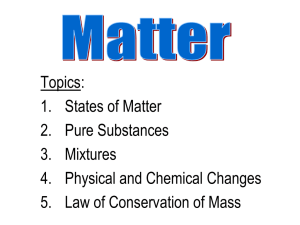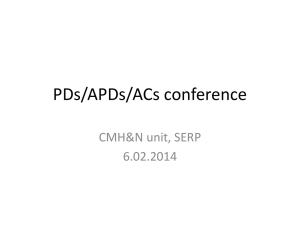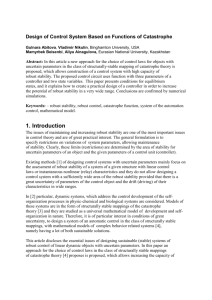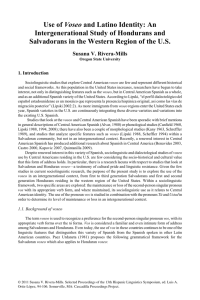What are volatile organic substances?
advertisement
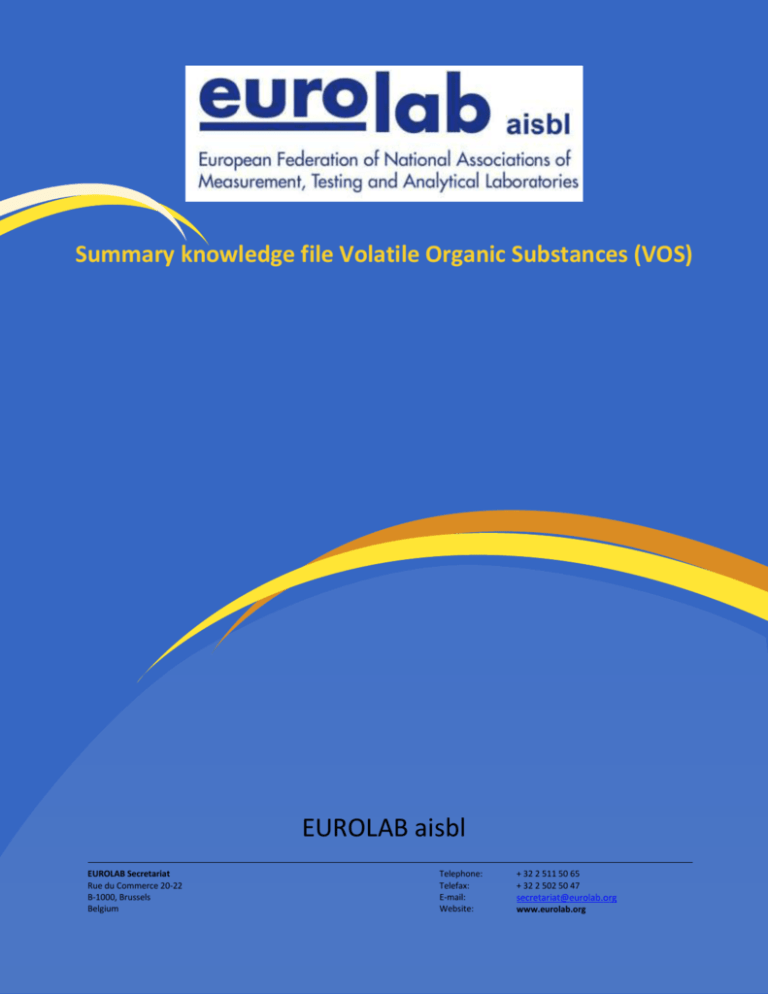
Summary knowledge file Volatile Organic Substances (VOS) EUROLAB aisbl EUROLAB Secretariat Rue du Commerce 20-22 B-1000, Brussels Belgium Telephone: Telefax: E-mail: Website: + 32 2 511 50 65 + 32 2 502 50 47 secretariat@eurolab.org www.eurolab.org WHAT ARE VOLATILE ORGANIC SUBSTANCES? This file discusses the health risks of organic substances that can be found in gaseous or vapour form at the workstation. It discusses methods for evaluation and control. The ratio between the vapour pressure of a substance and the occupational hygiene limit value is the central theme here. This approach is generally used in Europe as well as beyond for VOS (see Section 1.1.2 of the volatile organic substances file). Solvents constitute a large group in VOS. Sensory VOS can sometimes be perceived through the senses, but in many cases (carbon monoxide, hydrogen sulphide at high concentrations) the nose is a poor or an erroneous indicator (pleasant scent of some aromatics, acetates and vinyl chloride). Effects on health VOS have a multitude of effects on health which manifest directly or only following regular and prolonged exposure (see Section 1.1.2 of the volatile organic substances file). Some of the effects are discussed in other information files, such as: Knowledge file on Carcinogenic, Mutagenic, Reprotoxic Substances OPS The best known health aspect is the drugging effect of the organic solvents which are suspected of resulting in accelerated ageing of the brain functions following many years of exposure. This disorder is known as the ‘painter’s disease’, Organic Psycho Syndrome (OPS) or Chronic Toxic Encephalopathy (CTE). In most European countries OPS has been the reason for regulatory requirements and a practice for the diagnostics and the burden of liability for this occupational disease. The scientific relationship between OPS and solvents appears to be still uncertain. In other words, the extent to which OPS is harmful is not yet evidence based. Relevant work situations Nearly everyone is exposed to VOS, whether or not in an occupational capacity. This involves emissions from construction and decorating materials (paint, glue), lifestyle products (scents, etc), printing ink, cleaning products, pesticides, fuels, as well as substances released in preparation (cooking, frying), combustion (exhaust fumes) and rotting of organic materials. The estimate is that 2% of the working population can be seriously exposed while practicing their profession. These are usually persons who work with solvents, cleaning products and/or fuels (see Chapter 2 of the Knowledge file volatile organic substances. How does one find out if VOS are harmful? There are various instruments that can assist with carrying out a specific VOS risk inventory and evaluation (RI&E) (see Chapter 3 of the Knowledge file volatile organic substances. If more than one VOS is used at a job, the RI&E is usually focused on the VOS with the highest risk; volume, toxicity and volatility are the core factors in the evaluation. Control of the high risk substances usually implies that the other substances are under control as well. Exposure risks can be combined in cases where the critical toxic effect of the limit values of various VOS is equivalent (e.g. narcotic or toxic to the liver). Laboratory and conformity assessment services supporting European technology and trade Laboratory and conformity assessment services supporting European technology and trade There are various instruments for identifying the substance with a high potential risk in mixtures of VOS, such as the AWARE code for applying paint, and the Risk Assessment Score in DOHSBase Compare (subscription needed) for volatile substances in general. Exposure at the workstation can be evaluated by using models (such as the NL Stoffenmanager), measurements or by comparison to existing safe work methods. Exposure (concentration) must be measured and tested against existing limit values or limit values to be derived specifically for this in cases where there are no safe work methods or where these cannot be derived. What does the law say about VOS? Directive on the protection of the health and safety of workers from the risks related to chemical agents at work (98/24/EC) includes the definition of VOS and instructs one to substitute VOS as much as possible with harmless or less harmful substances (see Section 4.2 of the Knowledge file volatile organic substances). In addition, a number of articles and sections in the Occupational Health and Safety Regulation are relevant with respect to VOS (see Section 4.3 of the Knowledge file volatile organic substances). The remaining national statutory requirements focus chiefly on limiting VOS in paints and varnishes and on limiting emission of VOS to the environment (see Section 4.4 of the Knowledge file volatile organic substances). With the start of the REACH registration phase as of 1 December 2009, registration dossiers will have to be handed in for most VOS before 1 December 2010, including the following in the new safety data sheet (E-SDS): Exposure Scenarios; Chemical Safety Report; and the regulations for working safely (see Section 4.5 of the Knowledge file volatile organic substances). What can be done? Risk management measures (RMMs) are proposed in an occupational hygiene strategy on the basis of the results of the RI&E. These can vary from substitution of VOS or of the risky components in VOS (such as in the paint industry) to technical control measures (exhaust and ventilation) and personal protection equipment (surgical masks and overalls). For technical control measures, see Chapter 6 of the Knowledge file volatile organic substances). Laboratory and conformity assessment services supporting European technology and trade Laboratory and conformity assessment services supporting European technology and trade






